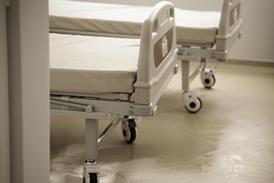Nick Sinclair, chief operating officer at Medway Foundation Trust, on why the NHS needs to think differently about operations and bed management to drive sustainable healthcare delivery
The NHS, like every health service in the developed world, is facing unprecedented challenges. Despite the huge efforts made by staff throughout the NHS, the combination of escalating pressures has led to capacity constraints, staff burnout and a growing elective care backlog. As healthcare becomes increasingly more constrained, the NHS will have to think differently about its approach to solving challenges by placing a greater emphasis on proven digital solutions that can improve care access, care delivery and care transitions across its healthcare ecosystem.
Sponsored by![]()
As the latest recovery report from the NHS confirms: “Patients are having to spend longer in A&E and waiting longer for ambulances. Hospitals are fuller than pre-pandemic, with 19 out of 20 beds occupied; up to 14,000 beds are occupied by someone who is clinically ready to leave; and the number of the most serious ambulance callouts has been at times up by one third on pre-pandemic levels. These pressures have also taken their toll on staff, who have had to work in an increasingly tough environment.”1
Staff shortages, an ageing population and the aftermath of a global pandemic are key contributors to the record waiting lists where backlogs in one area create massive challenges in others. One of the primary concerns is the occupancy level for general and acute hospital beds, with around 95 per cent of beds filled on average throughout 2022. High bed occupancy is a key driver of worsening ED performance, which in turn has a direct impact on ambulance “handover” and response times.
Key Facts to Consider:
- Delayed Discharges: The number of inpatients who do not clinically need to be in hospital increased by more than 10 per cent over the last year – accounting for around 13 per cent of occupied beds.2
- Escalating Staff Shortages: The King’s Fund analysis of new data reveals a 25 per cent increase in the number of NHS nurses leaving their role in the past year, with an additional 7,000 leaving compared to the previous year. The largest increase in numbers leaving was seen among the younger nurses with two thirds of leavers under 45 years of age.
- Growing Elective Care Backlog: More than 6 million people are now on an NHS waiting list, over one tenth of the population. This figure has increased by around a third since the start of the pandemic and lists are not expected to reduce before 2024 – even longer if the crisis in ED continues to force trusts to cancel elective surgery.
Improving operations starts with improving bed management
To address these issues, the NHS is taking a strategic approach. The latest Delivery Plan for Recovering Urgent and Emergency Care Services, published in January 2023, outlines five key strategy pillars designed to address waiting times and improve the patient experience.
The plan outlines commitments to increasing capacity and expanding the workforce; however, both goals will take time to achieve. The plan also acknowledges and addresses the well-accepted bottlenecks that occur throughout the urgent care system, most notably in bed management. For example, there are beds in the system that are not being optimally utilised due to the manual processes currently associated with bed management. By leveraging digital tools to release existing capacity, the NHS can maximise resources while transforming the experience both within EDs and across the wider integrated care ecosystem.
The Delivery Plan for Recovering Urgent and Emergency Care Services states: “NHS England will work with systems to support implementation of digital tools that support decision making in near real time, including electronic bed management systems both in hospitals and across other health and care settings. We expect the vast majority of trusts to have electronic bed management capabilities by summer 2023 and we will support all trusts to have implemented appropriate solutions by the end of the year.”
Why trusts need to prioritise electronic bed management technology and Care Co-ordination Centres
The NHS is not alone in needing to address operational challenges, staff shortages and growing elective care backlogs. Health services globally are looking at ways to serve as many patients as possible in the most efficient and effective manner. Improving and optimising bed management is critical to addressing the challenges that hospitals and health systems are facing globally. Currently, however, the information and processes required to ensure the effective management of beds across both acute trusts and the wider system do not work effectively together. A reliance on manual and paper-based processes, white boards, phone calls and dedicated bed management staff walking around a hospital trying to find empty beds is an inefficient way of capturing and sharing data, adding to both delays and staff pressures.
There is growing recognition that a more sophisticated approach is required to manage the complex operational logistics supporting patient flow. This can be done through Care Co-ordination Centres underpinned by healthcare Operations Platforms and electronic bed management technology, which have a vital role to play in the NHS digitalisation strategy. A recent King’sFund article emphasised the importance of interoperability, multidisciplinary collaboration and effective use of different, yet integrated, platforms to address the difficulties facing healthcare systems and patients accessing care.
Care Co-ordination Centres, underpinned by electronic bed management technology, have the potential to increase the visibility of vital information including available resources, bed utilisation, staffing workflows and discharge measures. With a single view of the entire trust, fast information sharing and efficient workflow optimisation, care access, care delivery and care transitions can be more effectively managed to the benefit of both patients and staff.
Electronic bed management capabilities
Electronic bed management systems combine advanced operational data and bed management software with clinical operations expertise to significantly improve care access, care delivery and care transitions and thereby increase capacity for patient care, across a hospital and wider health system.
The NHS must look at functionality, particularly real-time bed state and integration and automation around staffing workflows, that is designed for operational and logistical management and seamlessly integrates with all EPR/EMR systems to standardise and automate operational workflows across a hospital and system. This includes bed requests, bed cleaning, portering, ward flow management, and the discharge process, as well as automating operational workflows and creating real time data insights to enable better site management, capacity planning, staffing workflow optimisation and overall operational effectiveness. Importantly, it maximises the accessibility and use of existing bed capacity to improve patient flow.
What is a Care Co-ordination Centre?
A Care Co-ordination Centre is a proven approach to managing care access, transitions and delivery across a hospital and health system. These centres act as the “air traffic control” for a trust, monitoring and managing the day-to-day patient flow logistics and ensuring that patients are getting the right care, at the right time, in the right place, with the right resources. Managed by a combination of clinical and non-clinical staff, Care Co-ordination Centres act as the foundation for hospital operations, removing barriers so staff can focus on their priority: the patient.
By centralising data in one place, trusts gain complete visibility of bed capacity, enabling hospital operations to be managed more effectively and with fast response to ever-changing conditions.
For more information, register here for the free webinar: How can electronic bed management improve patient flow in hospitals? which takes place on 28 July 2023
References
1Delivery plan for recovering urgent and emergency care services January 2023
2Delivery plan for recovering urgent and emergency care services January 2023




























